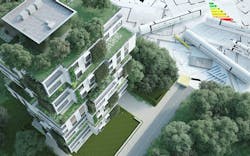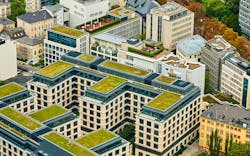Sustainability ultimately means meeting our present needs without compromising the ability of future generations to meet their needs. With such a broad definition, the practice of sustainability can be rather lofty and hard to pin down. So let’s narrow our field of vision and discuss sustainability as a design and construction principle, whereby a structure is designed to be sustainable (i.e., not relying heavily on non-replenishable resources) and is constructed or renovated using sustainable materials and certified techniques.
There are several ways to organize this discussion. However, for operational consistency, I will use the LEED (Leadership in Energy and Environmental Design) Building Design and Construction certification specifications as my North Star. More specifically, I will adhere to the v4.1 BD&C certification standard published in November 2020.
But we will not stop there. I would be remiss if I did not discuss sustainability through the lens of corporate social responsibility. For this first blog, we will start with sustainable construction design. Then, in coming weeks, we will talk of material and technique, then finish on the social front.
Starting with Sustainability in Mind
Achieving sustainability begins with innovative design that embeds resource utilization and responsibility in every part of the building and construction lifecycle: from initial design, to land utilization, to provisioned materials, to utilized equipment, to construction methods and, ultimately, ongoing operations and management. It does little good to repave an interstate highway with a noise-abating recycled compound if you are just going to dig up the existing surface with fossil-fuel-guzzling machinery that belches greenhouse gases and then dump the old surface material into a landfill. Sustainability must apply to the entire process from start to finish.
Fortunately, Gordian has tons of experience helping our clients procure and provision sustainable construction projects and services. Gordian recently helped the NYC Department of Education (DOE) and Department of Environmental Protection (DEP) with a sustainability project that checked all the boxes from conception through construction. What began as an effort to reduce water consumption during an aquifer repair quickly became a model for sustainable project design, innovation and execution.
The NYC DEP manages the flow of water from the Delaware River Watershed into New York City. The primary conduit, carrying over one billion gallons per day, is the Delaware Aqueduct. Built from 1939 to 1945, the aqueduct was found to be leaking over 36 million gallons of water per day. Obviously, repairs needed to be made. The DEP asked city planners to come up with a game plan to reduce city-wide water consumption by 25 million gallons per day.
With thousands of properties throughout the five boroughs, the NYC DOE was found to be one of the largest consumers of water. So the Department of Education –working with Gordian and our innovative Job Order Contracting solution (JOC) – embarked on an initiative to partner with local construction contractors to implement a program that would dramatically reduce water consumption across the department.
They immediately identified tens of thousands of low–efficiency plumbing fixtures that, if replaced, could reduce daily water consumption by several million gallons. The DOE selected specific high-efficiency replacement fixtures from their Construction Task Catalog© and qualified contractors from around the region competitively bid on the Indefinite Delivery/Indefinite Quantity (IDIQ) contract. The selected contractors worked closely with the Department of Education to replace the fixtures on time and on budget with minimum disruption to DOE operations.
Getting Creative to “Sustain” the Momentum
That was the initial project design part. But what do you do with 30,000 used toilets? Dumping them in a landfill certainly was not a very sustainable alternative. Here’s where the team really got creative.
Working again in partnership between the DOE, the DEP and the JOC team at Gordian, contractors were identified to responsibly sanitize the fixtures, remove any environmentally sensitive materials like corrosive metals or non-recyclable plastics and crush the porcelain to exacting standards to be used as artificial oyster beds in Jamaica Bay. These oyster beds not only provide a safe and effective habitat for sea life, but also improve water quality and avoid taking up landfill space.
However, the innovation did not end there! There were still thousands of toilets that were not used for oyster beds.
One consistent problem in the city is rain-water runoff. When storms hit, the runoff from gutters, streets and sidewalks can quickly overwhelm water management systems, potentially forcing untreated sewage into the water supply. Historically, the city purchased stone to create the sieve-like foundation for bioswales that allowed stormwater runoff to filter through “containers” filled with earthen substrate that irrigated streetscapes.
The same JOC contractor that helped with the oyster beds found that crushed porcelain was even more effective as bioswale foundational material than stone. And with the available supply of porcelain, no materials needed to be purchased. This additional project saved the city thousands of dollars, fully utilized the remaining crushed porcelain and created a sustainable method for handling storm-water runoff.
Sustainable Construction: Embracing Green, Grand Goals
Sustainable construction and building design is a big deal in New York City. As part of their Climate Mobilization Act, the city is implementing “Sustainable Roofing Zones” that deliver on the vision of converting available roof space into either clean energy production or green roofs designed to support plant-life and capture rainwater.
There is perhaps no better example of this than the Jacob Javits Convention Center in Manhattan. Winner of a LEED Silver award, the Javits Center replaced 6.75 acres of existing roof with a new green roof (plus new mechanical and electrical systems to boost operational efficiency). The resulting green space supports over 26 species of bird life, five bat species and thousands of honeybees. They are even able to harvest honey and sell it in the gift shop of the Convention Center. The Center has achieved 77% rainwater retention (which prevents almost seven million gallons of run-off per year) and has reduced annual energy consumption by over 26%.
Fortunately, New York is not the only city with green roof initiatives. To date, over 25 major metropolitan areas in North America have green roof programs in place.
Rainwater management is such an issue to sustainability overall that it is one of the first Low Impact Development (LID) criteria in the LEED Building Design and Construction certification guidelines. However, rainwater management is far from the only sustainable design criteria to be considered.
In the coming weeks, this multi-part blog series will further explore sustainable construction and building design guidelines, methods and examples from all parts of the building lifecycle.
About the Author

John Timmerman
John Timmerman has been in the tech industry since 1990. He has seen the emergence of just about every technology since the advent of the micro-chip. After 28 years in the Smart city and advanced analytics space, John is applying his wealth of understanding to Smart buildings (to include planning, design, construction and facilities management) in his role as Product Marketing Manager at Gordian.

